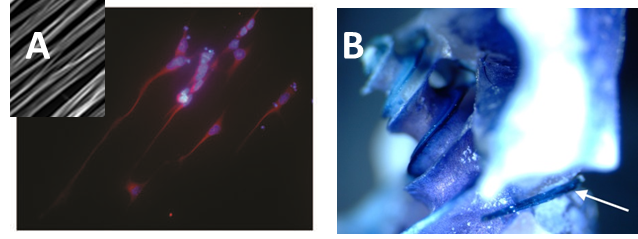Extraordinary demands of sensitivity and timing are placed on the cochlea, and as a result, small changes in cochlear physiology could greatly impact perception. Sensorineural deficits are often associated with the injury or destruction of sensory hair cells and/or auditory neurons. Therefore, a complete description of their structure and function, throughout development and maturation, is essential to understanding normal behavior, the response to injury and the requirements for regeneration. Two active projects in this area seek to regenerate auditory neurons and sensory hair cells using human pluripotent stem cells. Below we highlight one of our active projects in this area.
Stem Cell Regeneration of Auditory Neurons
Major challenges in stem cell therapy include the need to guide differentiation, guide sub-phenotypes and guide integration with host tissue. With the gracious help of Drs. Sue O’Shea and Rick Altschuler, we ventured into this field using a genetic tool to produce auditory-like neurons. Current projects are translating this work to human embryonic and induced-pluripotent stem cells using a combination of chemical and genetic cues.

 Stem cell-derived neurons are then seeded onto nanofibrous scaffolds (A) which are formed into a conduit for implantation in collaboration with Dr. Joseph Corey. Our surgical approach, in collaboration with Dr. Josef Miller and Ms. Diane Prieskorn, is to implant the seeded scaffold into the internal auditory canal of a deafened ear (B). Projects are underway to optimize infiltration of the scaffolds with stem cells, implantation, and evaluation of integration with the host tissue.
Stem cell-derived neurons are then seeded onto nanofibrous scaffolds (A) which are formed into a conduit for implantation in collaboration with Dr. Joseph Corey. Our surgical approach, in collaboration with Dr. Josef Miller and Ms. Diane Prieskorn, is to implant the seeded scaffold into the internal auditory canal of a deafened ear (B). Projects are underway to optimize infiltration of the scaffolds with stem cells, implantation, and evaluation of integration with the host tissue.

